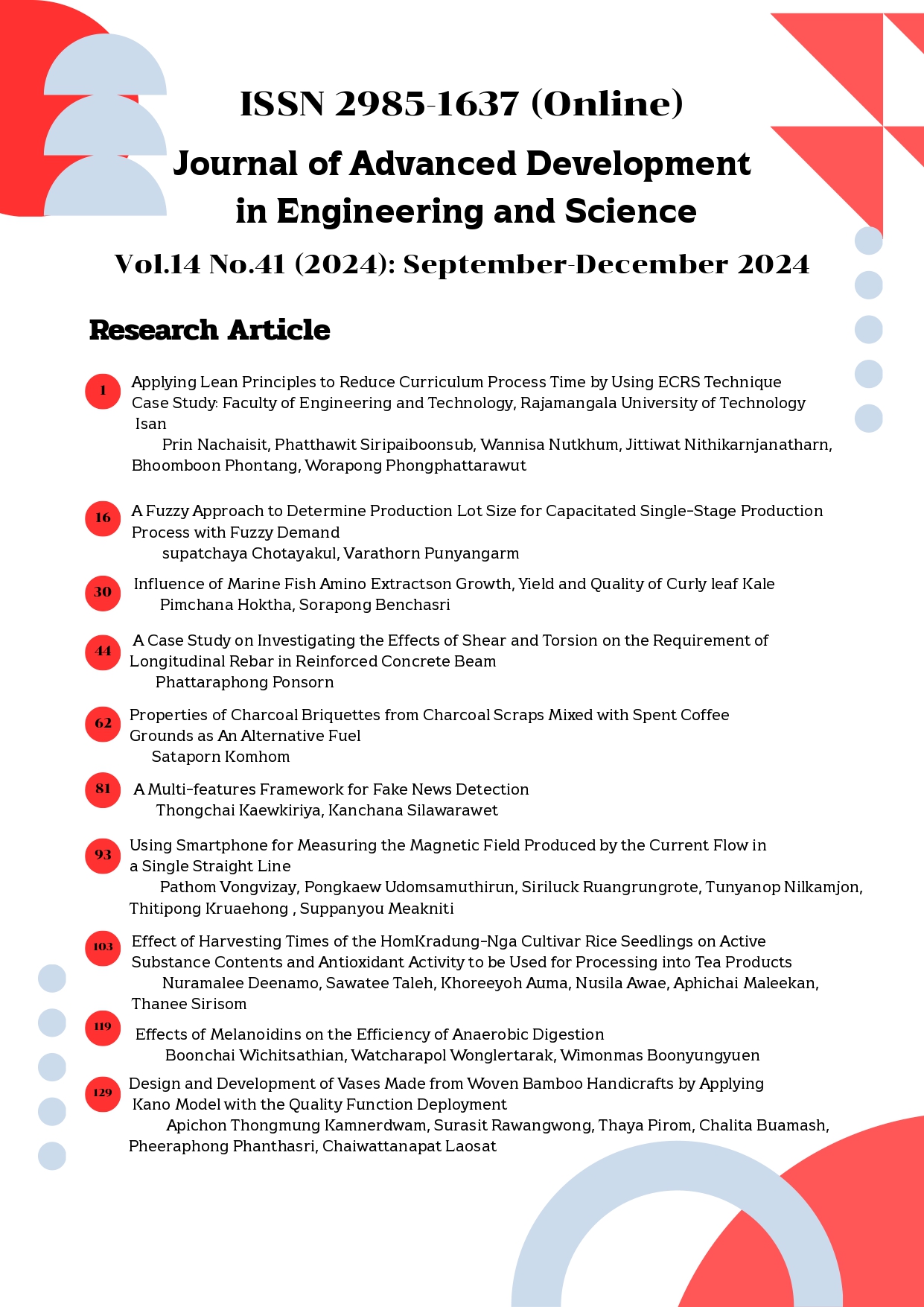A Multi-features Framework for Fake News Detection
Main Article Content
Abstract
Nowadays, social media is one of the key activities for the general public to share news and various stories with others. Consequently, there are malicious groups who seek to benefit themselves and cause societal disruption by creating and spreading fake news to the public. Recently, there have been efforts to develop systems for automatically detecting fake news on social media, such as using machine learning to analyze news data or employing systems to learn user behavior on social media. These methods have led to the concept of integrating multi-factor data analysis to enhance the accuracy of fake news detection systems. This research presents a multi-factor model for detecting fake news using techniques such as Term Frequency-Inverse Document Frequency (TF-IDF), concatenation, and neural networks, based on user posts. The dataset consists of 20,000 data entries, considering factors like headlines, sources, and user interactions. Testing the model with the Fakeddit.com fake news database revealed that the proposed model performs better in prediction accuracy compared to single-factor analysis and traditional machine learning methods, achieving an accuracy rate of 0.8504 (85.04%).
Article Details

This work is licensed under a Creative Commons Attribution-NonCommercial-NoDerivatives 4.0 International License.
The content and information in articles published in the Journal of Advanced Development in Engineering and Science are the opinions and responsibility of the article's author. The journal editors do not need to agree or share any responsibility.
Articles, information, content, etc. that are published in the Journal of Advanced Development in Engineering and Science are copyrighted by the Journal of Advanced Development in Engineering and Science. If any person or organization wishes to publish all or any part of it or to do anything. Only prior written permission from the Journal of Advanced Development in Engineering and Science is required.
References
Kumar, N., et al. (2018). Detecting review manipulation on online platforms with hierarchical supervised learning. Journal of Management Information Systems, 35(1), 350-380.
Burkhardt, J. M. (2017). Combating fake news in the digital age. Chicago: ALA TechSource.
Kim, A., et al. (2019). Combating fake news on social media with source ratings: The effects of user and expert reputation ratings. Journal of Management Information Systems, 39(3), 931-968.
Olan, F., et al. (2022). Fake news on social media: The impact on society. Information Systems Frontiers, 26(1), 443-458.
BBC. (2018). Sylvester Stallone ‘still punching’ despite death hoax. Available from https://www.bbc.com/news/world-us-canada-43130898. Accessed date: 20 February 2018.
Wu, Y., et al. (2020). Statistical analysis of dispelling rumors on Sina Weibo. Complexity, 2020, 3176593.
Silva, R. M., et al. (2020). Towards automatically filtering fake news in Portuguese. Expert Systems with Applications, 146, 113199.
Horne, B. D., et al. (2018). Assessing the news landscape: A multi-module toolkit for evaluating the credibility of news. In The Web Conference 2018 (p.235-238). 23 - 27 April, 2018, Lyon, France.
Przybyla, P. (2020). Capturing the style of fake news. In The 34th AAAI Conference on Artificial Intelligence (p.490-491). 7–12 February, 2020, New York, USA.
Jain, A., et al. (2019). A smart system for fake news detection using machine learning. In The 2019 International Conference on Issues and Challenges in Intelligent Computing Techniques (p. 1-4). 27-28 September, 2019, Ghaziabad, India.
Pizarro, J. (2020). Profiling bots and fake news spreaders at PAN’19 and PAN’20: Bots and gender profiling 2019, profiling fake news spreaders on Twitter 2020. In The 2020 IEEE 7th International Conference on Data Science and Advanced Analytics (p. 626-630). 6-9 October, 2020, Sydney, Australia.
Shu, K., et al. (2019). Beyond news contents: The role of social context for fake news detection. In The 12th ACM International Conference on Web Search and Data Mining (p. 312-320). 11–15 February, 2019, Melbourne, Australia.
Hamed, S. K., et al. (2023). Fake news detection model on social media by leveraging sentiment analysis of news content and emotion analysis of users’ comments. Sensors, 23(4), 1748.
Amini, A., et al. (2024). News source credibility assessment: A Reddit case study. arXiv: 2402.10938.
Proferes, N., et al. (2021). Studying Fakeddit: A systematic overview of disciplines, approaches, methods, and ethics. Social Media + Society, 7(2), 10.1177/20563051211019004.
Nakamura, K., et al. (2020). r/Fakeddit: A New Multimodal Benchmark Dataset for Fine-grained Fake News Detection. In The 12th Conference on Language Resources and Evaluation (p. 6149-6157). 11–16 May, 2020, Marseille, France.

